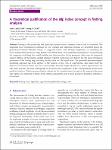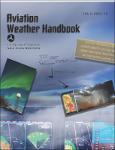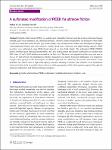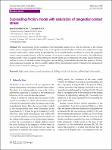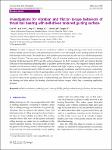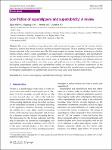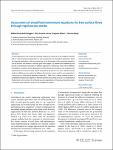Search
Author
- Agnese, Spadi (1)
- Alessandro A., Quarta (1)
- Alexander, Buchholz (1)
- Andrés, Guzmán (1)
- next >
Subject
Search Results
The last decade has witnessed a surge of interest in artificial neural network in many different areas of scientific research. Despite the rapid expansion in the application of neural networks, few efforts have been carried out to introduce such a powerful tool into lubrication studies. Thus, this work aims to apply the physics-informed neural network (PINN) to the hydrodynamic lubrication analysis. The 2D Reynolds equation is solved. The PINN is a meshless method and does not require big data for network training compared with classical methods. Our results are consistent with those obtained by experiments and the finite element method. Hence, we envision that the PINN method will have great application potential in lubrication and bearing research. |
Fretting in the partial-slip and gross-slip regimes under a constant normal load is considered. The tangential force—displacement relations for the forward and backward motions are described based the generalized Cattaneo—Mindlin theory of tangential contact and Masing’s hypothesis on modelling the force—displacement hysteretic loop. Besides the critical force and displacement parameters (characterizing the triggering of sliding), the model includes one dimensionless fitting parameter that tunes the tangential contact stiffness of the friction—contact interface. Explicit expressions are derived for the main tribological parameters of the fretting loop, including the slip index and the signal index. |
This handbook describes the United States (U.S.) aviation weather program, products, and services. It also documents weather theory and its application to aviation. The objective of this handbook is to help the pilot and operator understand the basics of weather, aviation weather hazards, and aviation weather products. The information included is not prescriptive. Furthermore, the guidance and recommendations in this handbook are not legally binding in their own right and will not be relied upon by the FAA as a separate basis for affirmative enforcement action or other administrative penalty. Conformity with the guidance and recommendations is voluntary only and nonconformity will not affect rights and obligations under existing statutes and regulations. |
Triboelectric nanogenerator (TENG) based on triboelectrification has attracted wide attention due to its effective utilization of green energy sources such as marine energy. However, researches about liquid-liquid triboelectrification are still scanty as solid—liquid triboelectrification has been widely studied. Herein, this work focuses on the hydrophobic/slippery substrate—water interfacial triboelectrification based on the solid friction materials of polytetrafluoroethylene (PTFE) nanoparticles. The hydrophobic/slippery substrate—water interfacial triboelectrification are studied by assembling PTFE coated Al sheets and perfluoropolyether (PFPE) infused PTFE coated Al sheets (formed the slippery lubricant-infused surfaces (SLIPSs)) as the friction electrode, and water as liquid fr... |
Polyether ether ketone (PEEK) is a widely used material for friction pairs due to its excellent mechanical strength, good wear resistance, and chemical inertness. However, some modifications are necessary when PEEK is used as a water-lubricated friction pair. In this study, a novel sulfonation method was developed to design a water-lubricated friction pair with ultralow friction, good wear resistance, and high loading capacity. PEEK powders were sulfonated using ClSO3H and sintered to form bulk plastic. The sulfonated PEEK (SPEEK) plastic exhibited good tribological properties. At a low sliding speed, the friction coefficient was smaller than 0.02 when a 3 wt% NaCl solution was used as the lubricant. The order of magnitude of the wear rate was as low as 10−8 mm3/(N·m). |
The incorporation of the saturation of the tangential contact stress with the increase of the normal contact stress is required for the analysis of the friction phenomenon of solids and structures subjected to a high normal contact stress, which cannot be described by the Coulomb friction condition, in which the tangential contact stress increases linearly with the increase of the normal contact stress. In this article, the subloading-friction model, which is capable of describing the smooth elastic—plastic transition, the static—kinetic transition, and the recovery of the static friction during the cease of sliding, is extended to describe this property. Further, some numerical examples are shown, and the validity of the present model will be verified by the simulation of the test ... |
In order to improve the starved lubrication condition of rolling bearings, three kinds of textures, namely dimple, groove texture, and gradient groove texture, were developed on the guiding surface of thrust ball bearings in this study. The results show that gradient groove texture has the one-way self-driving function of liquid droplets. The root mean square (RMS) value of vibration acceleration of gradient groove textured bearing (GGB) decreased by 49.1% and the kurtosis decreased by 24.6% compared with non-textured bearing (NB) due to the directional spreading effect of gradient groove textures on oil. |
The issues regarding energy dissipation and component damage caused by the interface friction between a friction pair attract enormous attention to friction reduction. The key-enabling technique to realize friction reduction is the use of lubricants. The lubricants smooth the contact interfaces, achieving an ultralow friction contact, which is called superslippery or superlubricity. At present, superslippery and superlubricity are two isolated research topics. There is a lack of unified definition on superslippery and superlubricity from the viewpoint of tribology. Herein, this review aims at exploring the differences and relations between superslippery and superlubricity from their origin and application scenarios. Meanwhile, the challenges for developing superslippery surface and ... |
In many applications, free surface flow through rigid porous media has to be modeled. Examples refer to coastal engineering applications as well as geotechnical or biomedical applications. Albeit the frequent applications, slight inconsistencies in the formulation of the governing equations can be found in the literature. The main goal of this paper is to identify these differences and provide a quantitative assessment of different approaches. Following a review of the different formulations, simulation results obtained from three alternative formulations are compared with experimental and numerical data. Results obtained by 2D and 3D test cases indicate that the predictive differences returned by the different formulations remain small for most applications, in particular for small... |
Abrasive wear mechanisms—including two-body and three-body abrasion—dominate the performance and lifespan of tribological systems in many engineering fields, even of those operating in lubricated conditions. Bearing steel (100Cr6) pins and discs in a flat-on-flat contact were utilized in experiments together with 5 and 13 µm Al2O3-based slurries as interfacial media to shed light on the acting mechanisms. The results indicate that a speed-induced hydrodynamic effect occurred and significantly altered the systems’ frictional behavior in tests that were performed using the 5 µm slurry. Further experiments revealed that a speed-dependent hydrodynamic effect can lead to a 14% increase in film thickness and a decrease in friction of around 2/3, accompanied by a transition from two-body a... |


